Bond Relationship of Carbon Fiber-Reinforced Polymer (CFRP) Strengthened Steel Plates Exposed to Service Temperature
Abstract
:1. Introduction
2. Experimental Program
2.1. Methods
2.2. Material Properties
2.3. Specimens Preparation and Testing Procedures
2.3.1. Tensile Bonding (Double Strap Joint)
2.3.2. Flexural Bonding (Four-Point Loading)
2.3.3. Environmental Exposure
3. Results and Discussion
3.1. Failure Modes Due to Tensile and Flexural Bonding
3.2. Tensile Bonding Results
3.2.1. Ultimate Load Capacity versus Displacement
3.2.2. Bond Stress
3.2.3. The Effect of Service Temperature, CFRP Layers and Bond Length
3.3. Flexural Bonding
3.3.1. Ultimate Load Capacity versus Deflection
3.3.2. Bending Moment, Resilience and Toughness
3.3.3. The Effect of Service Temperature, CFRP Layers and Bond Length
3.4. FESEM Analysis
3.5. Response Surface Methodology
3.5.1. ANOVA Analysis
3.5.2. Optimization
4. Conclusions
- 1-
- In tensile bonding, increases in temperature from 25 °C to 70 °C increases the ultimate load capacity by 25.62%, 48.79% and 60.71% after strengthening with one, three and five layers of CFRP, respectively. Increases in bond length also increase strength by about 11.01%. Increasing the CFRP to five layers with respect to the bond length can increase the strength capacity by about three times.
- 2-
- In flexural bonding, service temperatures show a mild effect on CFRP-strengthening steel plates compared to CFRP layers and bond length. The ultimate load increases marginally by, on average, only 2.06% as the temperature increases from 25 °C to 70 °C. The ultimate load capacity increases by 2.26% with a 40 mm bond length as the number of CFRP layers increase from one to five, whereas as the CFRP layers increase, using an 80 mm and 120 mm bond length, the ultimate load capacity can remarkedly improve, by 47.39% and 87.61%, respectively.
- 3-
- The softening effects of the adhesive at service temperatures reduces particle microstructure gaps to form a densified and homogenous interface and further improve the bonding strength of the adhesive.
- 4-
- Two empirical equations with quadratic models are proposed by RSM using a Box–Behnken design (BBD) to estimate the tensile strength and flexural strength of CFRP-strengthened steel plates by considering service temperature, number of CFRP layers and bond length. The optimum tensile strength and flexural strength were achieved by bond length, number of CFRP layers and temperature at 117 mm, 5 layers and 70 °C, respectively.
Author Contributions
Funding
Institutional Review Board Statement
Informed Consent Statement
Data Availability Statement
Acknowledgments
Conflicts of Interest
Appendix A
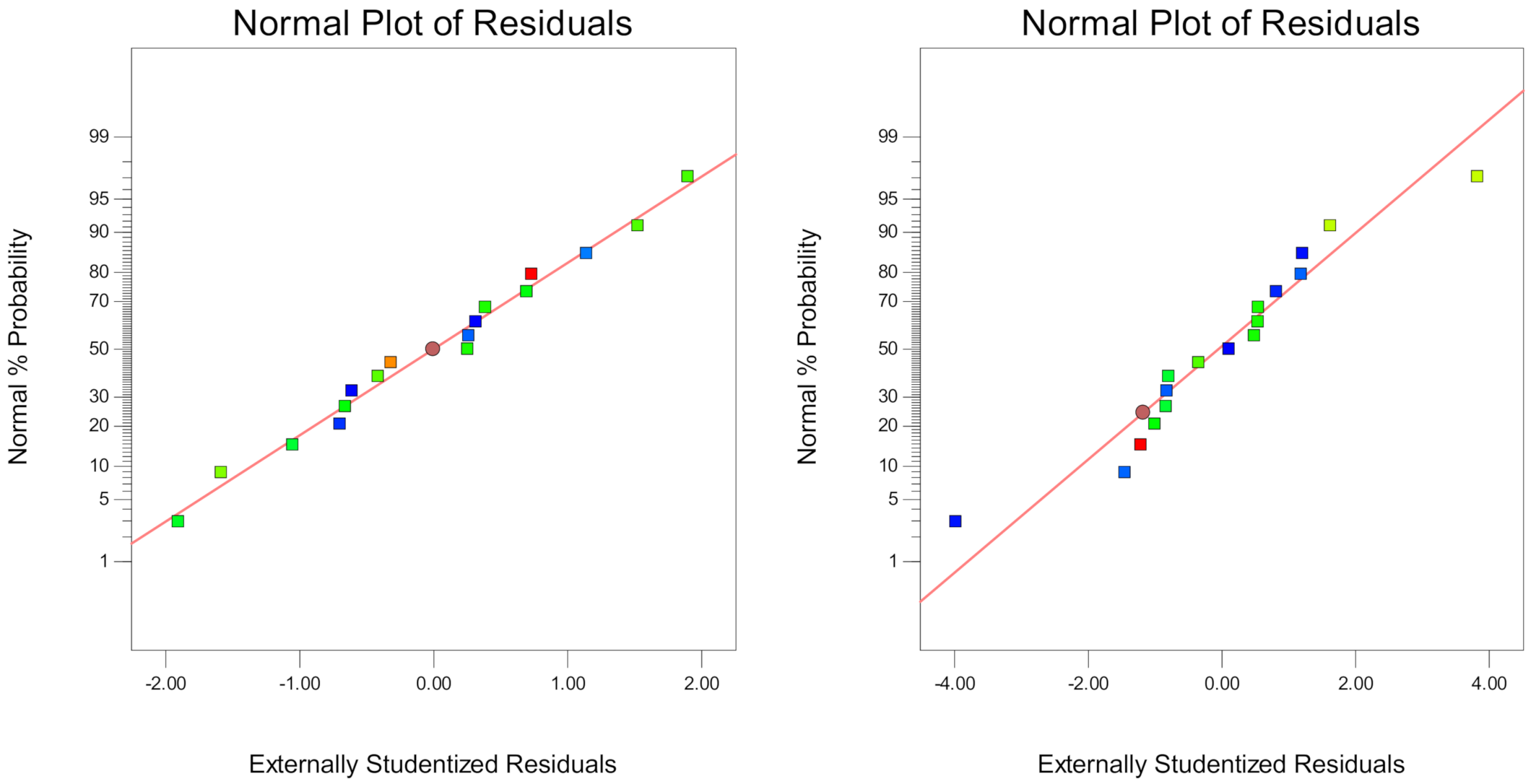
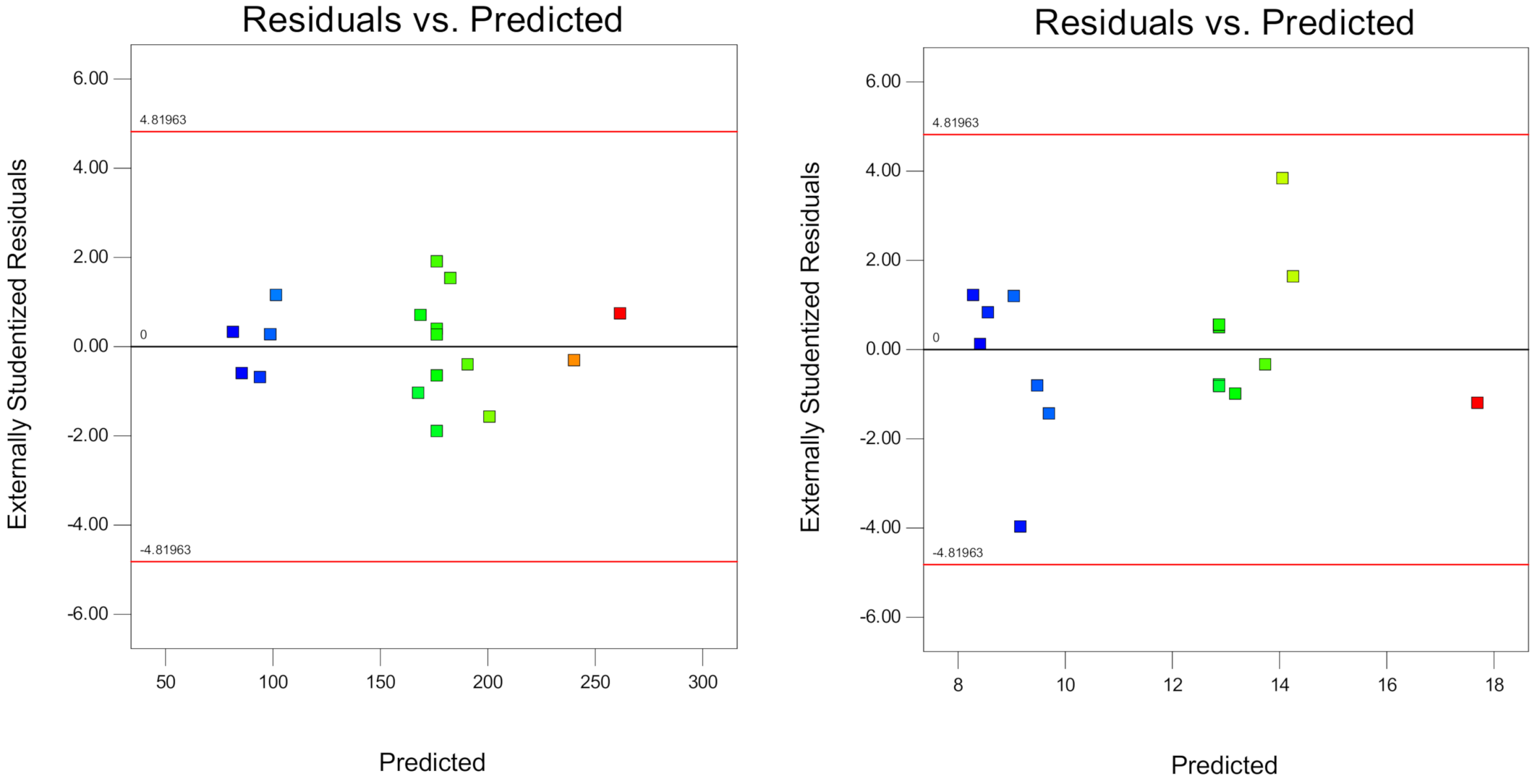
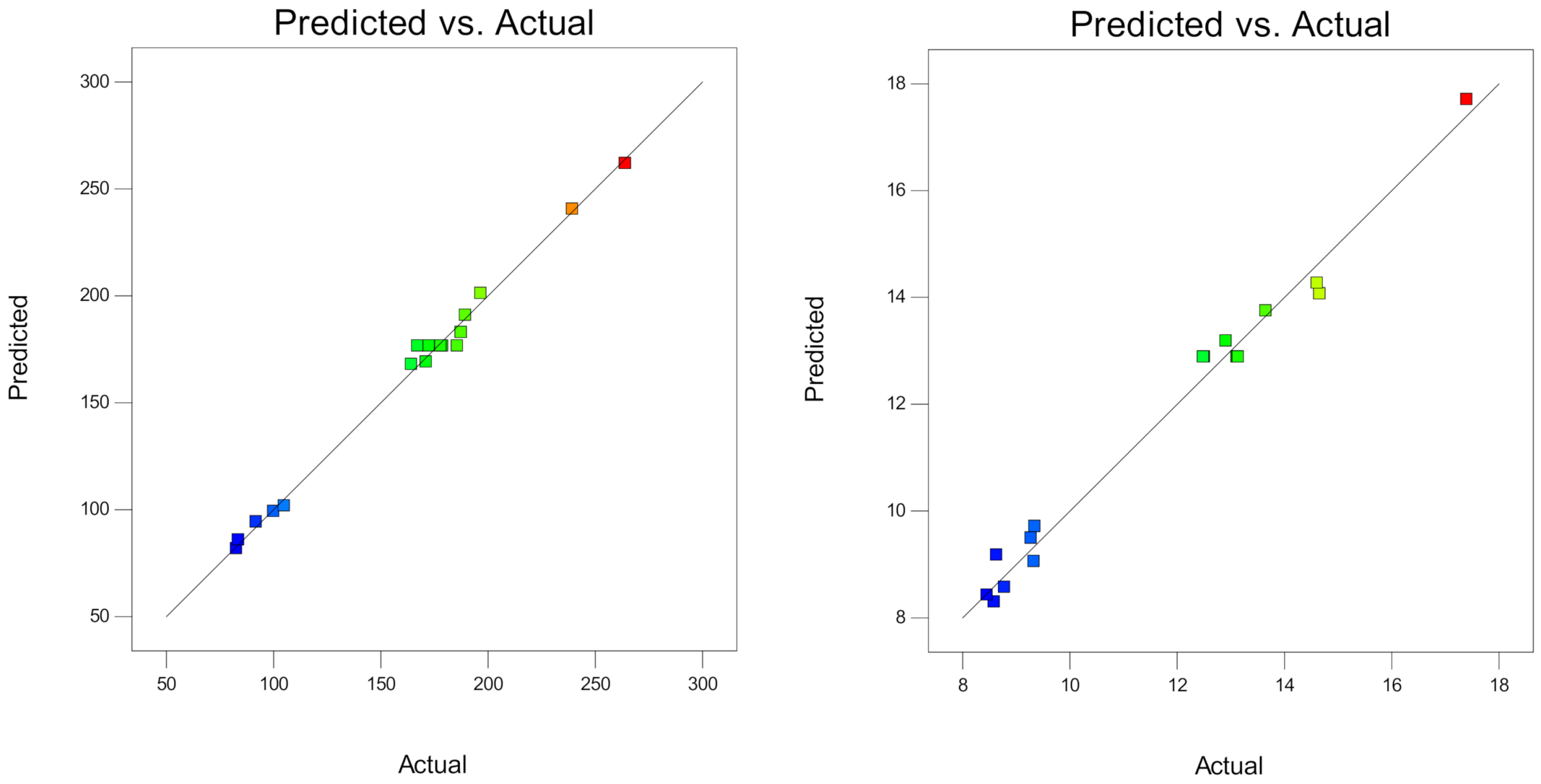
References
- Borrie, D.; Liu, H.B.; Zhao, X.L.; Singh Raman, R.K.; Bai, Y. Bond durability of fatigued CFRP-steel double-lap joints pre-exposed to marine environment. Compos. Struct. 2015, 131, 799–809. [Google Scholar] [CrossRef]
- Ou, Y.; Zhu, D.; Zhang, H.; Yao, Y.; Mobasher, B.; Huang, L. Mechanical properties and failure characteristics of CFRP under intermediate strain rates and varying temperatures. Compos. Part B Eng. 2016, 95, 123–136. [Google Scholar] [CrossRef]
- Lye, H.L.; Mohammed, B.S.; Liew, M.S.; Wahab, M.M.A.; Al-Fakih, A. Bond behaviour of CFRP-strengthened ECC using Response Surface Methodology (RSM). Case Stud. Constr. Mater. 2020, 12, e00327. [Google Scholar] [CrossRef]
- Ke, L.; Li, C.; He, J.; Dong, S.; Chen, C.; Jiao, Y. Effects of elevated temperatures on mechanical behavior of epoxy adhesives and CFRP-steel hybrid joints. Compos. Struct. 2020, 235. [Google Scholar] [CrossRef]
- Bai, Y.; Keller, T. Effects of thermal loading history on structural adhesive modulus across glass transition. Constr. Build. Mater. 2011, 25, 2162–2168. [Google Scholar] [CrossRef]
- Yao, M.; Zhu, D.; Yao, Y.; Zhang, H.; Mobasher, B. Experimental study on basalt FRP/steel single-lap joints under different loading rates and temperatures. Compos. Struct. 2016, 145, 68–79. [Google Scholar] [CrossRef]
- Feng, P.; Hu, L.; Zhao, X.-L.; Cheng, L.; Xu, S. Study on thermal effects on fatigue behavior of cracked steel plates strengthened by CFRP sheets. Thin Walled Struct. 2014, 82, 311–320. [Google Scholar] [CrossRef]
- Nguyen, T.-C.; Bai, Y.; Zhao, X.-L.; Al-Mahaidi, R. Mechanical characterization of steel/CFRP double strap joints at elevated temperatures. Compos. Struct. 2011, 93, 1604–1612. [Google Scholar] [CrossRef]
- Lu, Y.; Li, W.; Li, S.; Li, X.; Zhu, T. Study of the Tensile Properties of CFRP Strengthened Steel Plates. Polymers 2015, 7, 2595–2610. [Google Scholar] [CrossRef] [Green Version]
- Li, S.; Zhu, T.; Lu, Y.; Li, X. Effect of Temperature Variation on Bond Characteristics between CFRP and Steel Plate. Int. J. Polym. Sci. 2016, 2016, 1–8. [Google Scholar] [CrossRef]
- He, J.; Xian, G.; Zhang, Y.X. Effect of moderately elevated temperatures on bond behaviour of CFRP-to-steel bonded joints using different adhesives. Constr. Build. Mater. 2020, 241. [Google Scholar] [CrossRef]
- Chandrathilaka, E.R.K.; Gamage, J.C.P.H.; Fawzia, S. Mechanical characterization of CFRP/steel bond cured and tested at elevated temperature. Compos. Struct. 2019, 207, 471–477. [Google Scholar] [CrossRef]
- Chandrathilaka, E.R.K.; Gamage, J.C.P.H.; Fawzia, S. Numerical modelling of bond shear stress slip behavior of CFRP/steel composites cured and tested at elevated temperature. Compos. Struct. 2019, 212, 1–10. [Google Scholar] [CrossRef]
- Zhou, H.; Urgel, J.M.; Emberley, R.; Maluk, C.; Fernando, D. Behaviour of the FRP-to-steel bonded joints under elevated temperature. Changes 2017, 19, 21st. [Google Scholar]
- Zhou, H.; Torres, J.P.; Fernando, D.; Law, A.; Emberley, R. The bond behaviour of CFRP-to-steel bonded joints with varying bond properties at elevated temperatures. Eng. Struct. 2019, 183, 1121–1133. [Google Scholar] [CrossRef] [Green Version]
- Qin, G.; Na, J.; Mu, W.; Tan, W.; Yang, J.; Ren, J. Effect of continuous high temperature exposure on the adhesive strength of epoxy adhesive, CFRP and adhesively bonded CFRP-aluminum alloy joints. Compos. Part B Eng. 2018, 154, 43–55. [Google Scholar] [CrossRef]
- Banea, M.D.; Silva, L.F.M.d.; Campilho, R.D.S.G. Effect of Temperature on Tensile Strength and Mode I Fracture Toughness of a High Temperature Epoxy Adhesive. J. Adhes. Sci. Technol. 2012, 26, 939–953. [Google Scholar] [CrossRef]
- Hu, P.; Han, X.; Li, W.D.; Li, L.; Shao, Q. Research on the static strength performance of adhesive single lap joints subjected to extreme temperature environment for automotive industry. Int. J. Adhes. Adhes. 2013, 41, 119–126. [Google Scholar] [CrossRef]
- Michels, J.; Widmann, R.; Czaderski, C.; Allahvirdizadeh, R.; Motavalli, M. Glass transition evaluation of commercially available epoxy resins used for civil engineering applications. Compos. Part B Eng. 2015, 77, 484–493. [Google Scholar] [CrossRef]
- Sahin, M.U.; Dawood, M. Experimental Investigation of Bond between High-Modulus CFRP and Steel at Moderately Elevated Temperatures. J. Compos. Constr. 2016, 20. [Google Scholar] [CrossRef]
- Liu, H.B.; Zhao, X.L.; Bai, Y.; Singh, R.K.; Rizkalla, S.; Bandyopadhyay, S. The Effect of Elevated Temperature on the Bond Between High Modulus Carbon Fibre-Reinforced Polymer Sheet and Steel. Aust. J. Struct. Eng. 2014, 15, 355–366. [Google Scholar] [CrossRef]
- Goud, V.; Ramasamy, A.; Das, A.; Kalyanasundaram, D. Box-Behnken technique based multi-parametric optimization of electrostatic spray coating in the manufacturing of thermoplastic composites. Mater. Manuf. Process. 2019, 34, 1638–1645. [Google Scholar] [CrossRef]
- Al-Fakih, A.; Wahab, M.M.A.; Mohammed, B.S.; Liew, M.S.; Zawawi, N.A.W.A.; As’ ad, S. Experimental study on axial compressive behavior of rubberized interlocking masonry walls. J. Build. Eng. 2020, 29, 101107. [Google Scholar] [CrossRef]
- ASTM D3039/D3039M-08. Standard Test Method for Tensile Properties of Polymer Matrix Composite Materials; ASTM: West Conshohocken, PA, USA, 2008. [Google Scholar]
- ASTM E8/E8M. Standard Test Methods for Tension Testing of Metallic Materials; ASTM: West Conshohocken, PA, USA, 2008. [Google Scholar]
- ASTM D638. Standard Test Method for Tensile Properties of Plastics; ASTM: West Conshohocken, PA, USA, 2014. [Google Scholar]
- Korayem, A.H.; Chen, S.J.; Zhang, Q.H.; Li, C.Y.; Zhao, X.L.; Duan, W.H. Failure of CFRP-to-steel double strap joint bonded using carbon nanotubes modified epoxy adhesive at moderately elevated temperatures. Compos. Part B Eng. 2016, 94, 95–101. [Google Scholar] [CrossRef]
- ASTM D6272. Standard Test Method for Flexural Properties of Unreinforced and Reinforced Plastics and Electrical Insulating Materials by Four-Point Bending; ASTM: West Conshohocken, PA, USA, 2008. [Google Scholar]
- Sika Kimia. Product Data Sheet: Sikadur®-330; Sika Kimia Sdn. Bhd.: Negeri Sembilan, Malaysia, 2017. [Google Scholar]
- He, J.; Xian, G. Debonding of CFRP-to-steel joints with CFRP delamination. Compos. Struct. 2016, 153, 12–20. [Google Scholar] [CrossRef]
- Zhao, X.-L. FRP-Strengthened Metallic Structures; CRC Press: Taylor & Francis Group: Boca Raton, FL, USA, 2013. [Google Scholar]
- Wu, C.; Zhao, X.; Hui Duan, W.; Al-Mahaidi, R. Bond characteristics between ultra high modulus CFRP laminates and steel. Thin Walled Struct. 2012, 51, 147–157. [Google Scholar] [CrossRef]
- Proia, A.; Matthys, S. Influence of environmental conditions on the glass transition temperature of epoxy used for strengthening applications. Polym. Test. 2019, 79, 106012. [Google Scholar] [CrossRef]
- Firmo, J.P.; Roquette, M.G.; Correia, J.R.; Azevedo, A.S. Influence of elevated temperatures on epoxy adhesive used in CFRP strengthening systems for civil engineering applications. Int. J. Adhes. Adhes. 2019, 93, 102333. [Google Scholar] [CrossRef]
- Li, C.; Ke, L.; He, J.; Chen, Z.; Jiao, Y. Effects of mechanical properties of adhesive and CFRP on the bond behavior in CFRP-strengthened steel structures. Compos. Struct. 2019, 211, 163–174. [Google Scholar] [CrossRef]
- Yu, T.; Fernando, D.; Teng, J.G.; Zhao, X.L. Experimental study on CFRP-to-steel bonded interfaces. Compos. Part B Eng. 2012, 43, 2279–2289. [Google Scholar] [CrossRef]
- Al-Mosawe, A.; Al-Mahaidi, R.; Zhao, X.-L. Bond behaviour between CFRP laminates and steel members under different loading rates. Compos. Struct. 2016, 148, 236–251. [Google Scholar] [CrossRef]
- Wang, H.-T.; Wu, G.; Dai, Y.-T.; He, X.-Y. Experimental Study on Bond Behavior between CFRP Plates and Steel Substrates Using Digital Image Correlation. J. Compos. Constr. 2016, 20. [Google Scholar] [CrossRef]
- Li, N.; Li, S.; Liu, C.; Zhu, T. Bond behavior of CFRP/steel double strap joint at elevated temperatures. Preprints 2018. [Google Scholar] [CrossRef]
- Zeng, J.-J.; Gao, W.-Y.; Liu, F. Interfacial behavior and debonding failures of full-scale CFRP-strengthened H-section steel beams. Compos. Struct. 2018, 201, 540–552. [Google Scholar] [CrossRef]
- Schnerch, D.; Dawood, M.; Rizkalla, S.; Sumner, E.; Stanford, K. Bond behavior of CFRP strengthened steel structures. Adv. Struct. Eng. 2006, 9, 805–817. [Google Scholar] [CrossRef]
- Hassein Abed, G. Effects of temperature on the adhesive bonding in steel beams reinforced with CFRP composites. Ph.D. Thesis, University of Southampton, Southampton, UK, 2012. [Google Scholar]
- Shivamurthy, B.; Murthy, K.; Anandhan, S. Tribology and Mechanical Properties of Carbon Fabric/MWCNT/Epoxy Composites. Adv. Tribol. 2018, 2018, 1–10. [Google Scholar] [CrossRef] [Green Version]
- Swamy, G.J.; Sangamithra, A.; Chandrasekar, V. Response surface modeling and process optimization of aqueous extraction of natural pigments from Beta vulgaris using Box–Behnken design of experiments. Dye. Pigment. 2014, 111, 64–74. [Google Scholar] [CrossRef]
- Jesthi, D.K.; Nayak, R.K. Influence of glass/carbon fiber stacking sequence on mechanical and three-body abrasive wear resistance of hybrid composites. Mater. Res. Express 2020, 7. [Google Scholar] [CrossRef]
- Qiu, P.; Cui, M.; Kang, K.; Park, B.; Son, Y.; Khim, E.; Jang, M.; Khim, J. Application of Box-Behnken design with response surface methodology for modeling and optimizing ultrasonic oxidation of arsenite with H2O2. Open Chem. 2014, 12, 164–172. [Google Scholar] [CrossRef]
- Behera, S.K.; Meena, H.; Chakraborty, S.; Meikap, B.C. Application of response surface methodology (RSM) for optimization of leaching parameters for ash reduction from low-grade coal. Int. J. Min. Sci. Technol. 2018, 28, 621–629. [Google Scholar] [CrossRef]
- Loutas, T.H.; Sotiriadis, G.; Tsonos, E.; Psarras, S.; Kostopoulos, V. Investigation of a pulsed laser ablation process for bonded repair purposes of CFRP composites via peel testing and a design-of-experiments approach. Int. J. Adhes. Adhes. 2019, 95. [Google Scholar] [CrossRef]
- Hamlaoui, N.; Azzouz, S.; Chaoui, K.; Azari, Z.; Yallese, M.A. Machining of tough polyethylene pipe material: Surface roughness and cutting temperature optimization. Int. J. Adv. Manuf. Technol. 2017, 92, 2231–2245. [Google Scholar] [CrossRef]
- Mohammed, B.S.; Achara, B.E.; Nuruddin, M.F.; Yaw, M.; Zulkefli, M.Z. Properties of nano-silica-modified self-compacting engineered cementitious composites. J. Clean. Prod. 2017, 162, 1225–1238. [Google Scholar] [CrossRef]
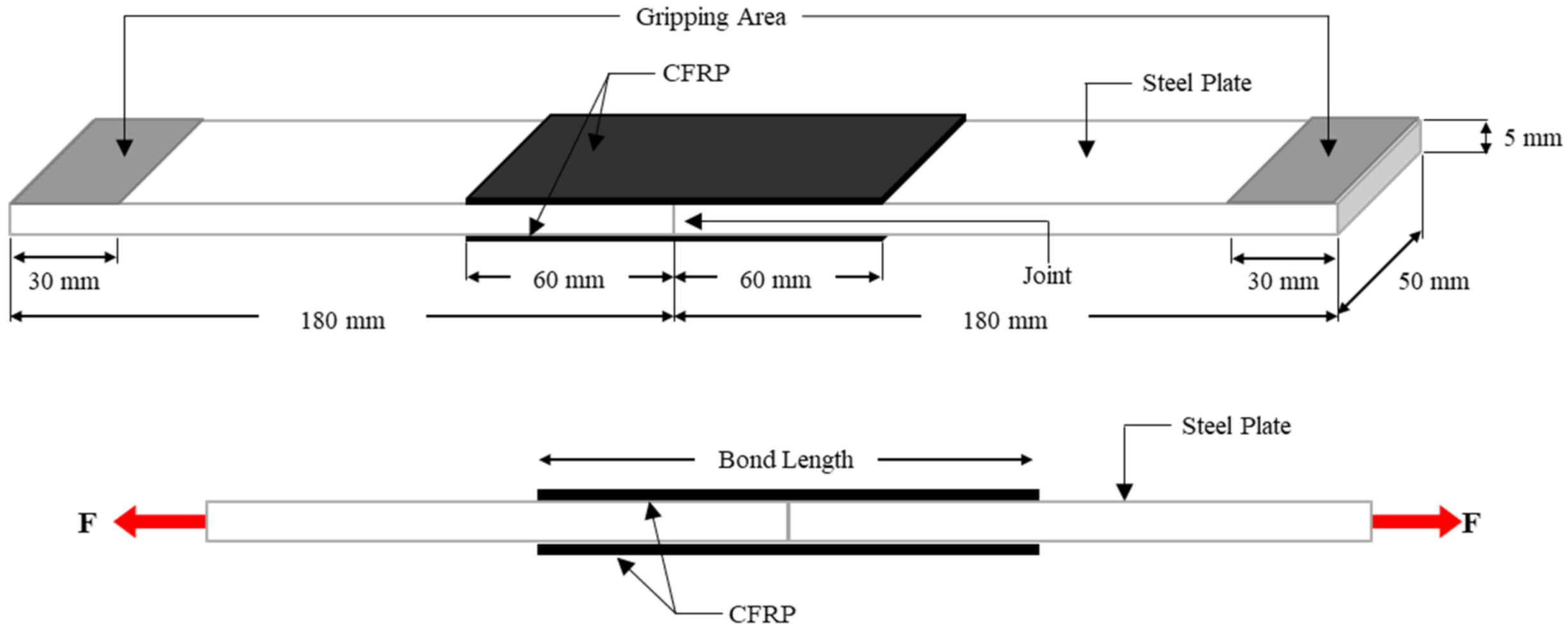
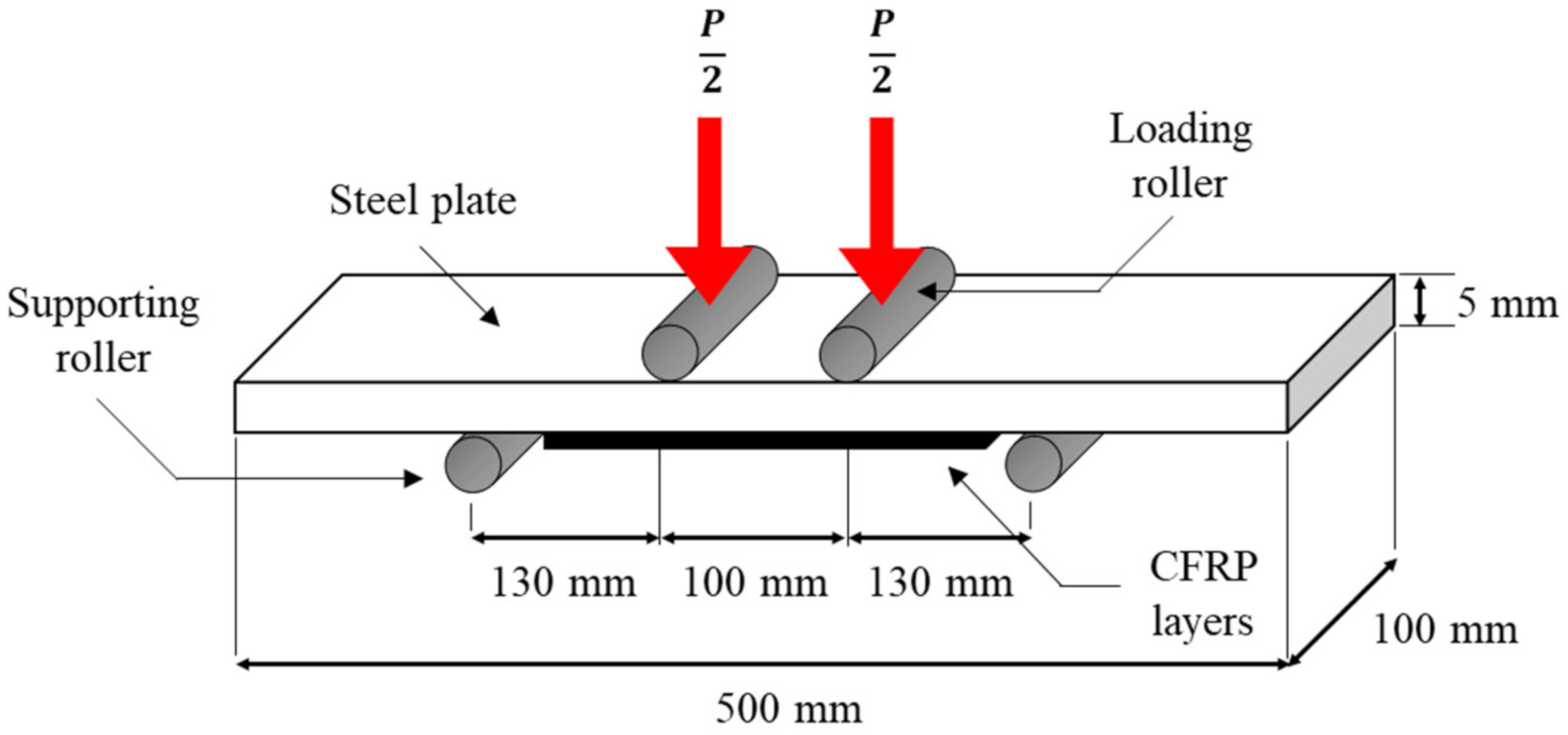
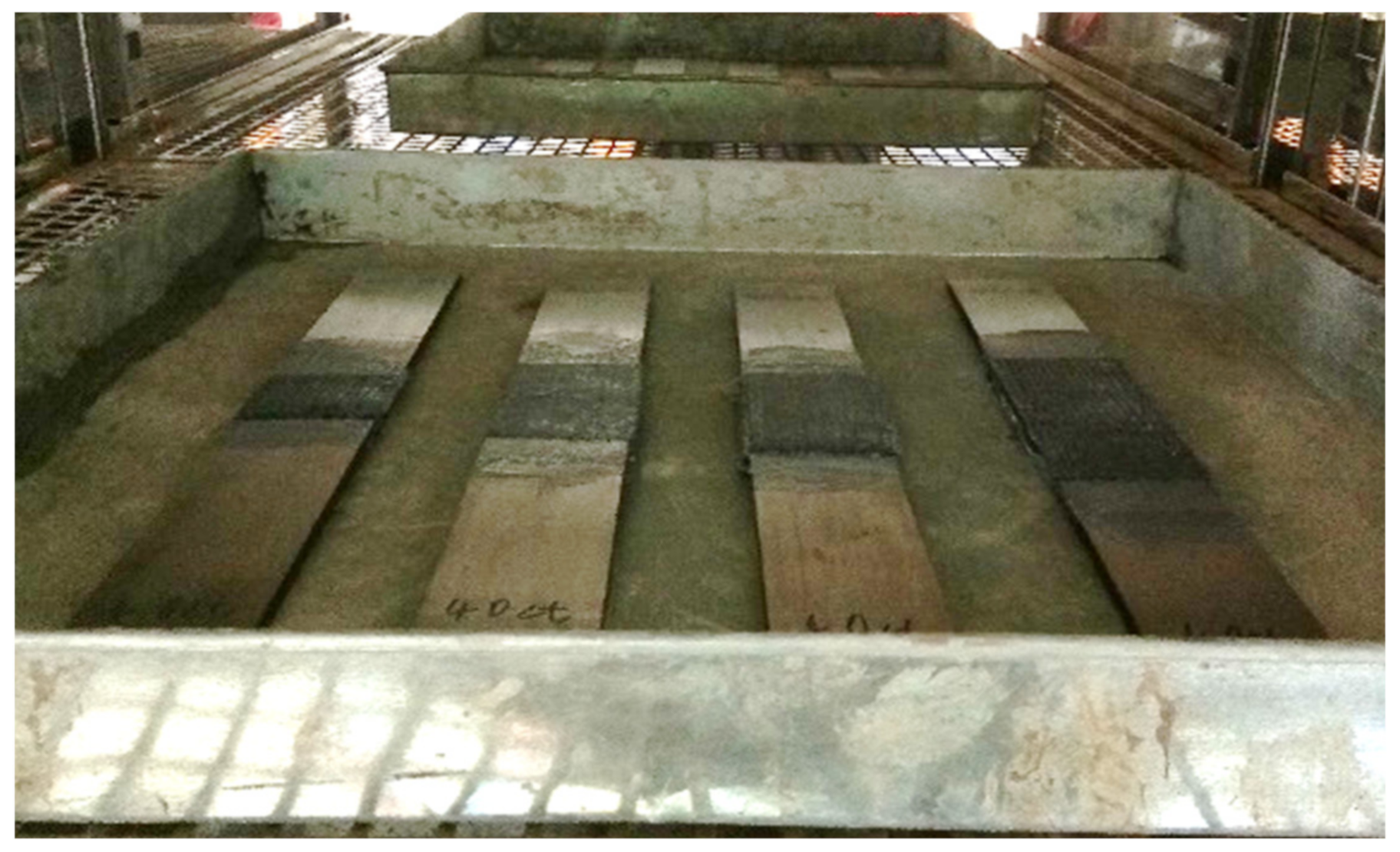
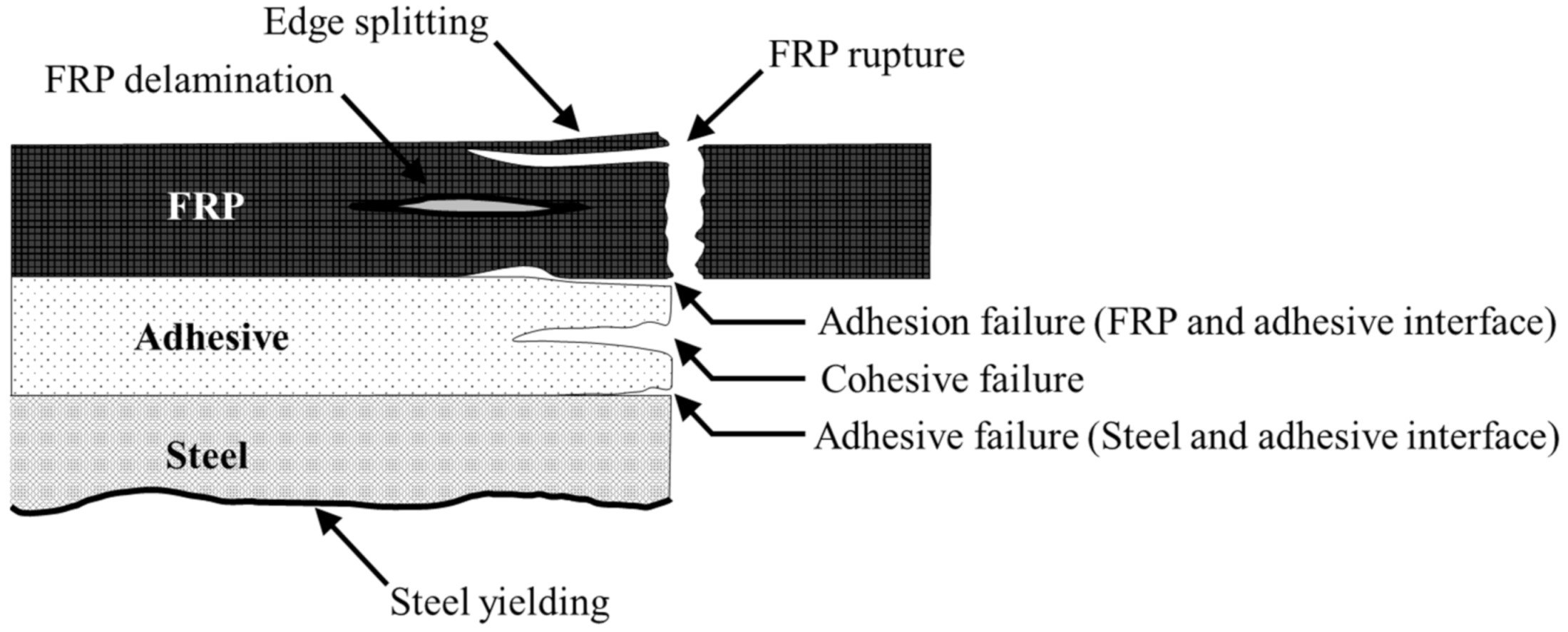
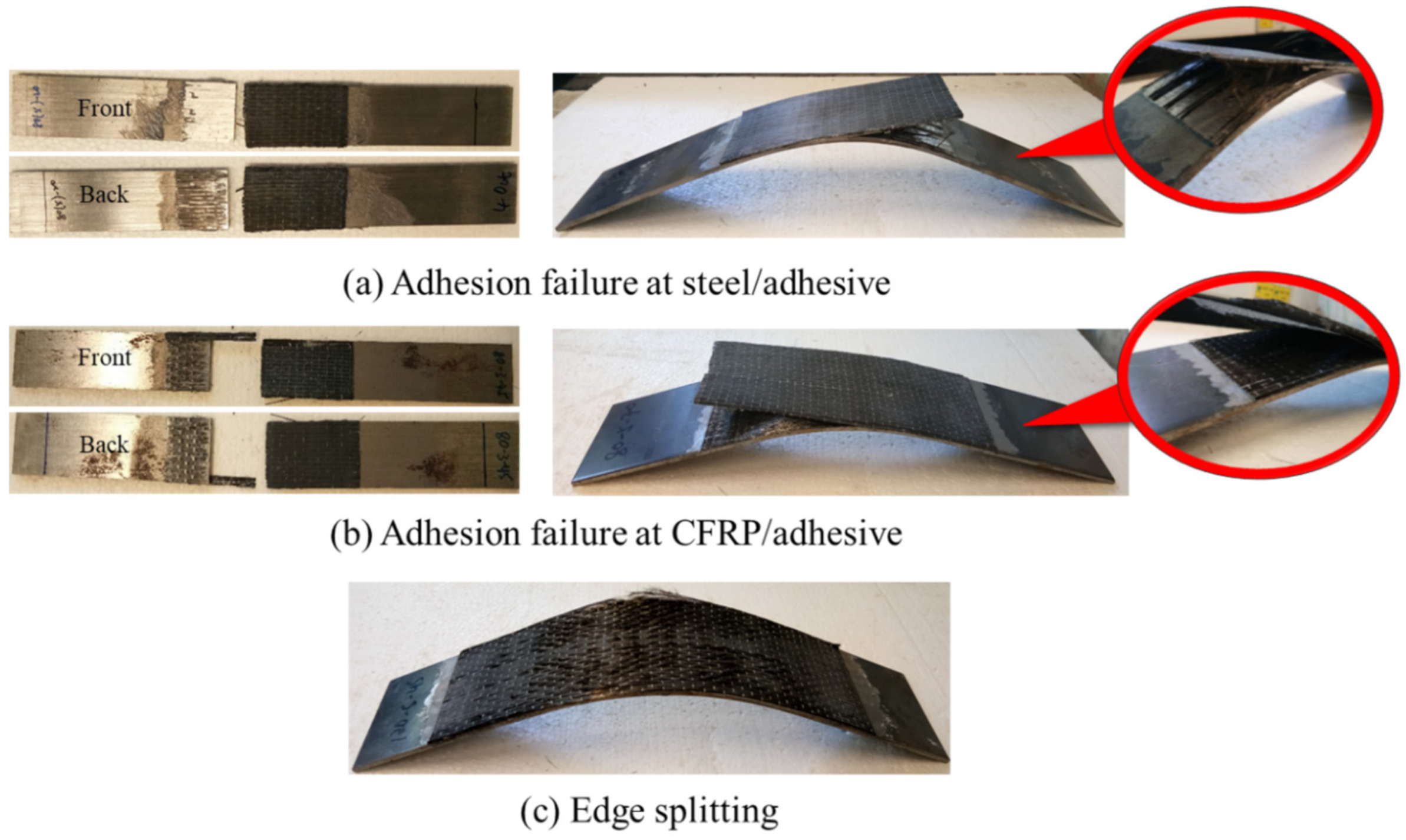
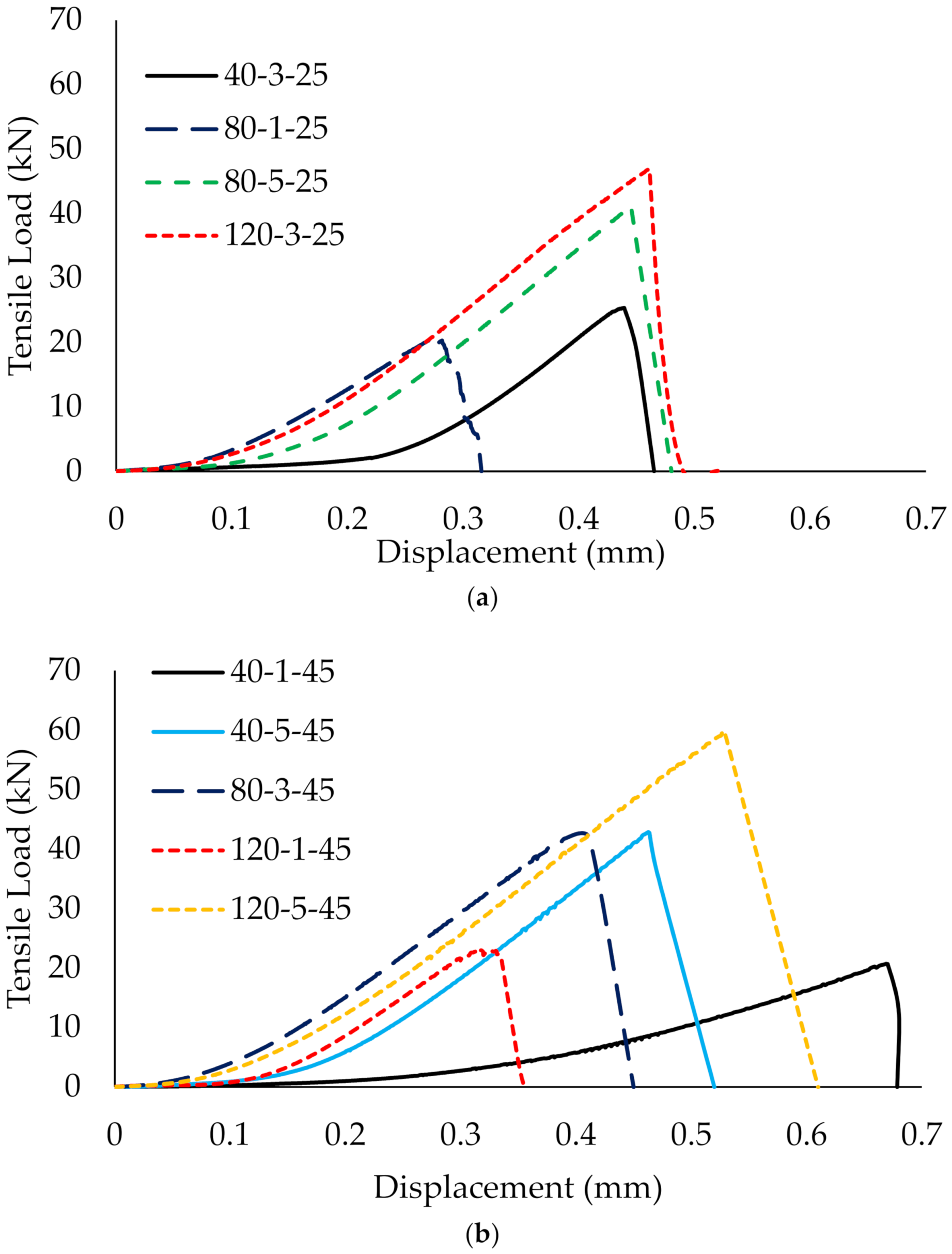

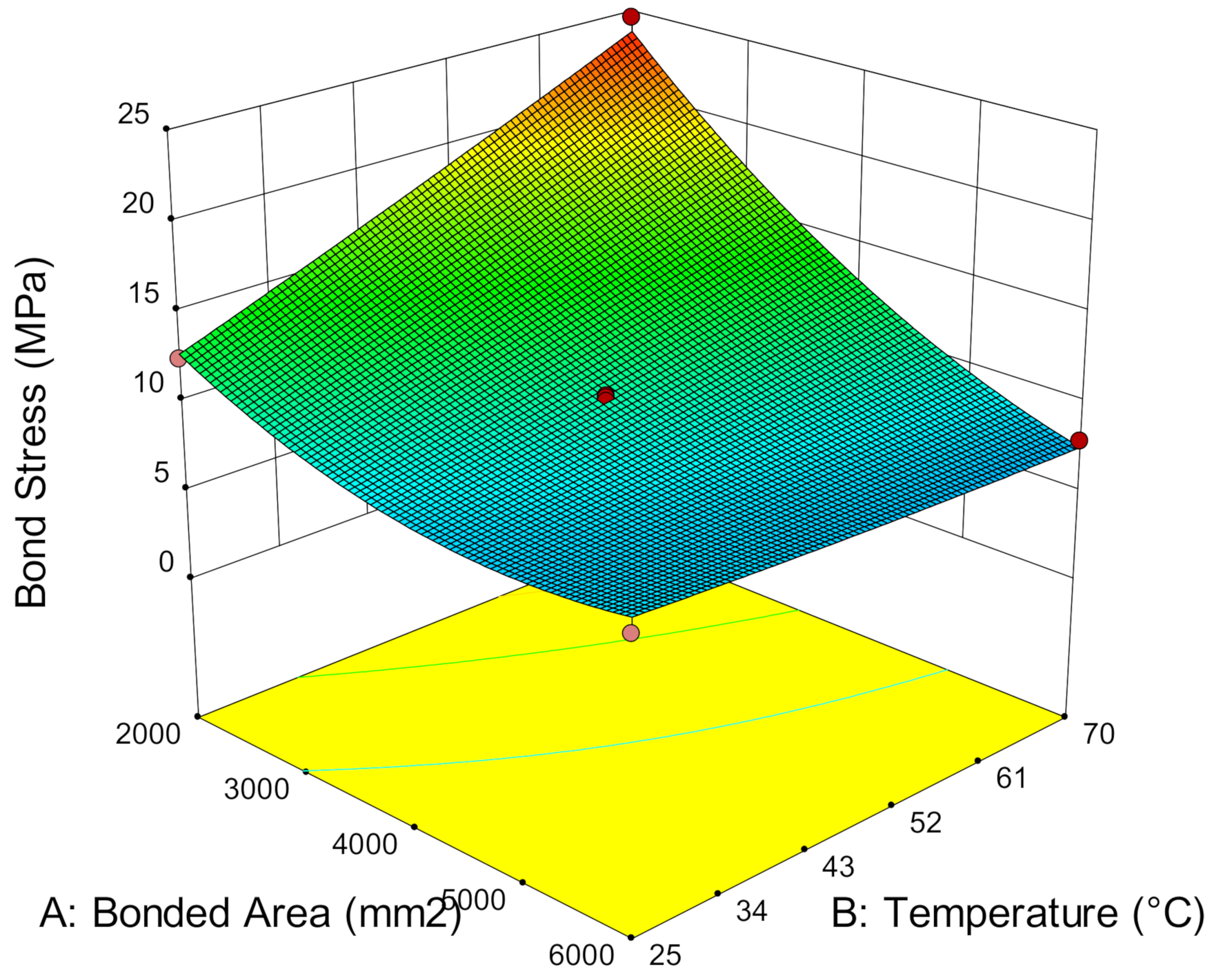

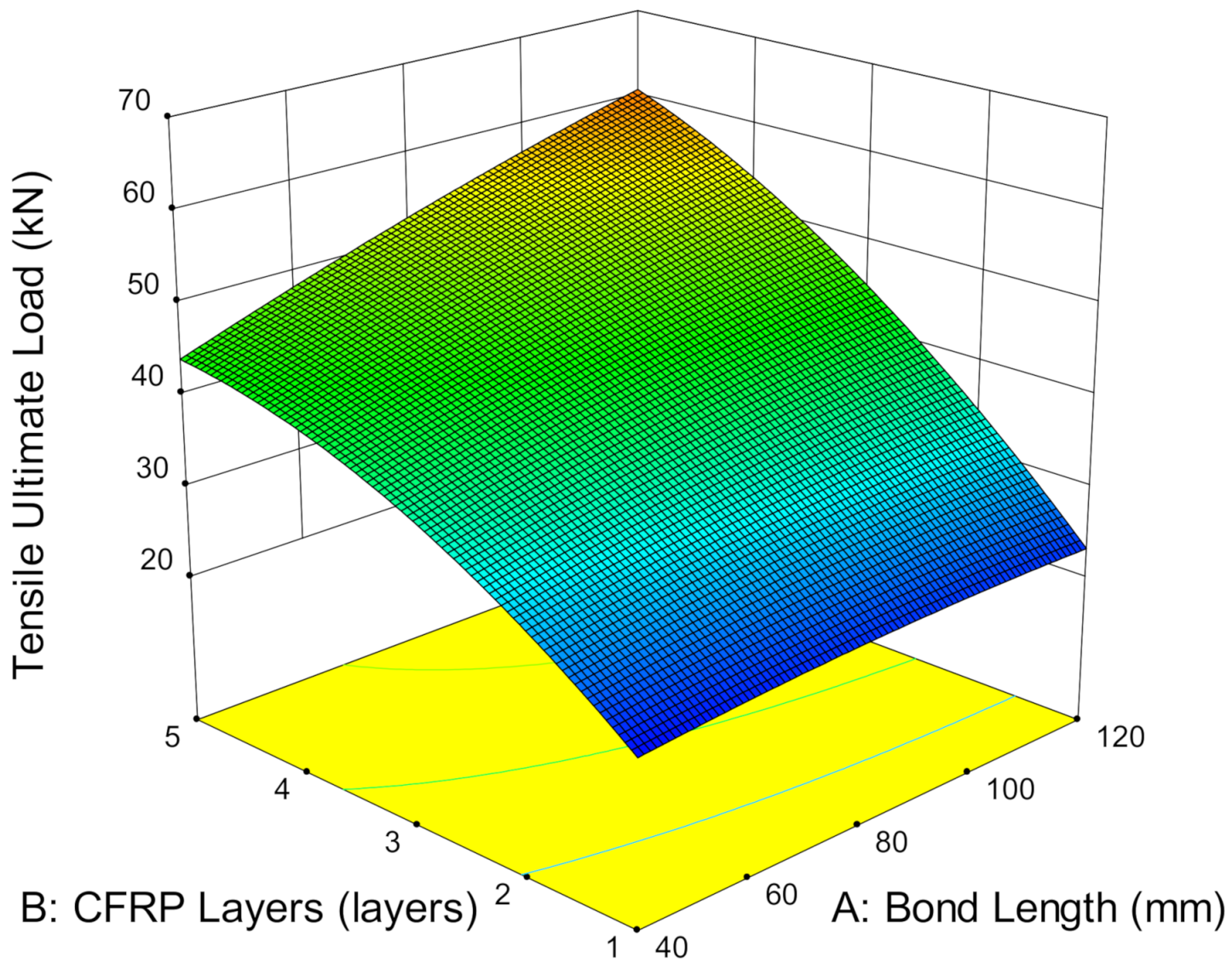
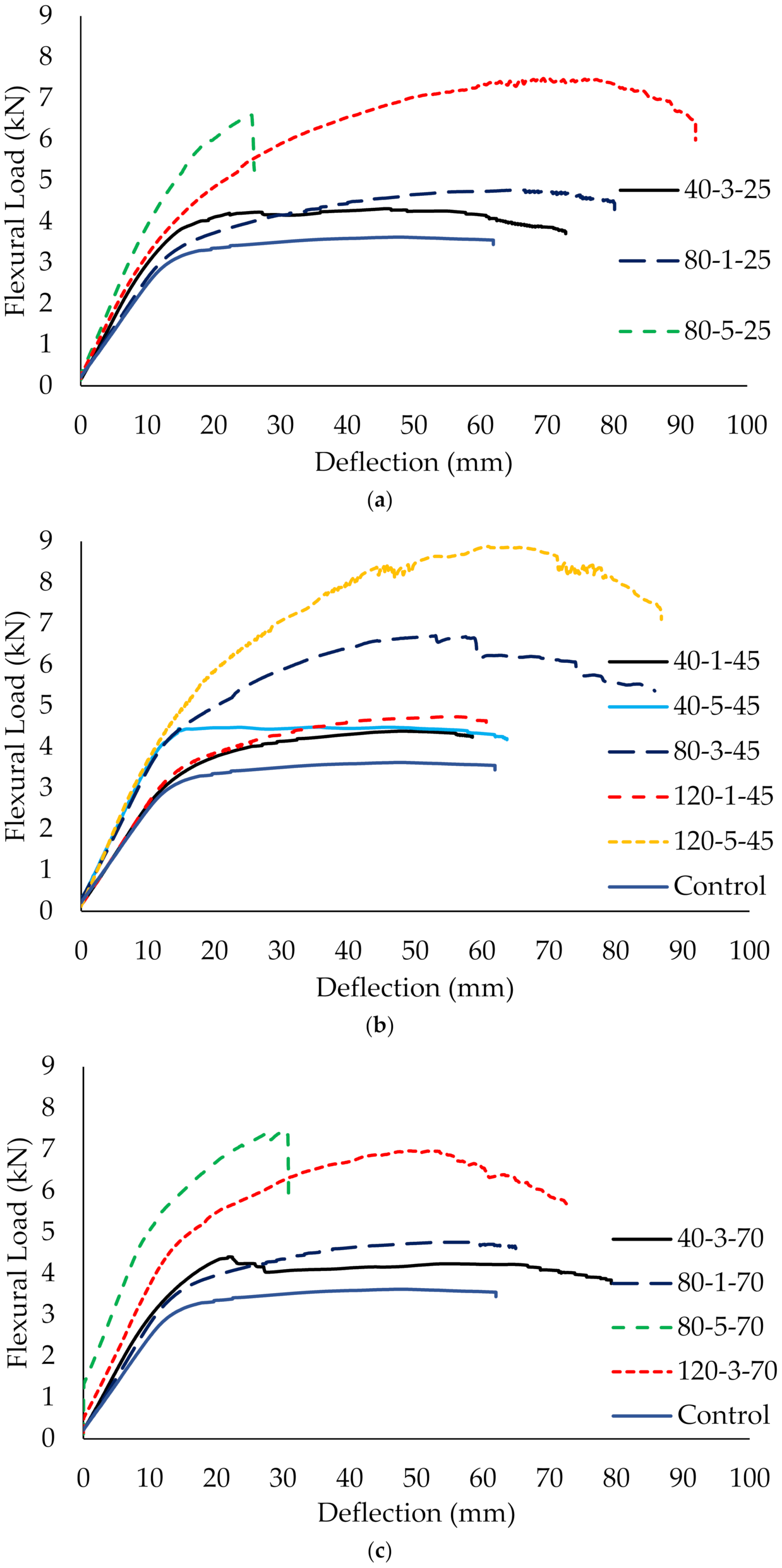


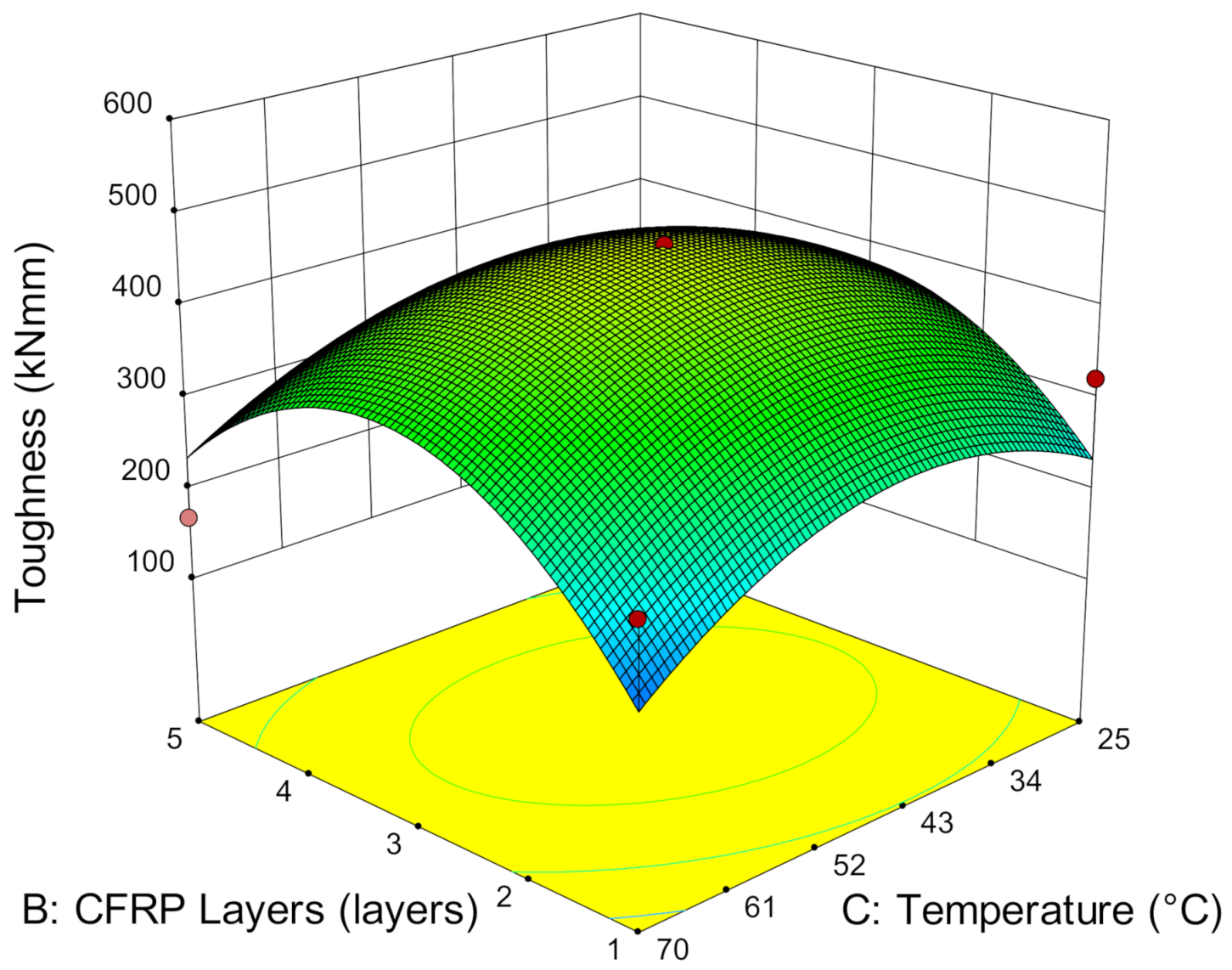
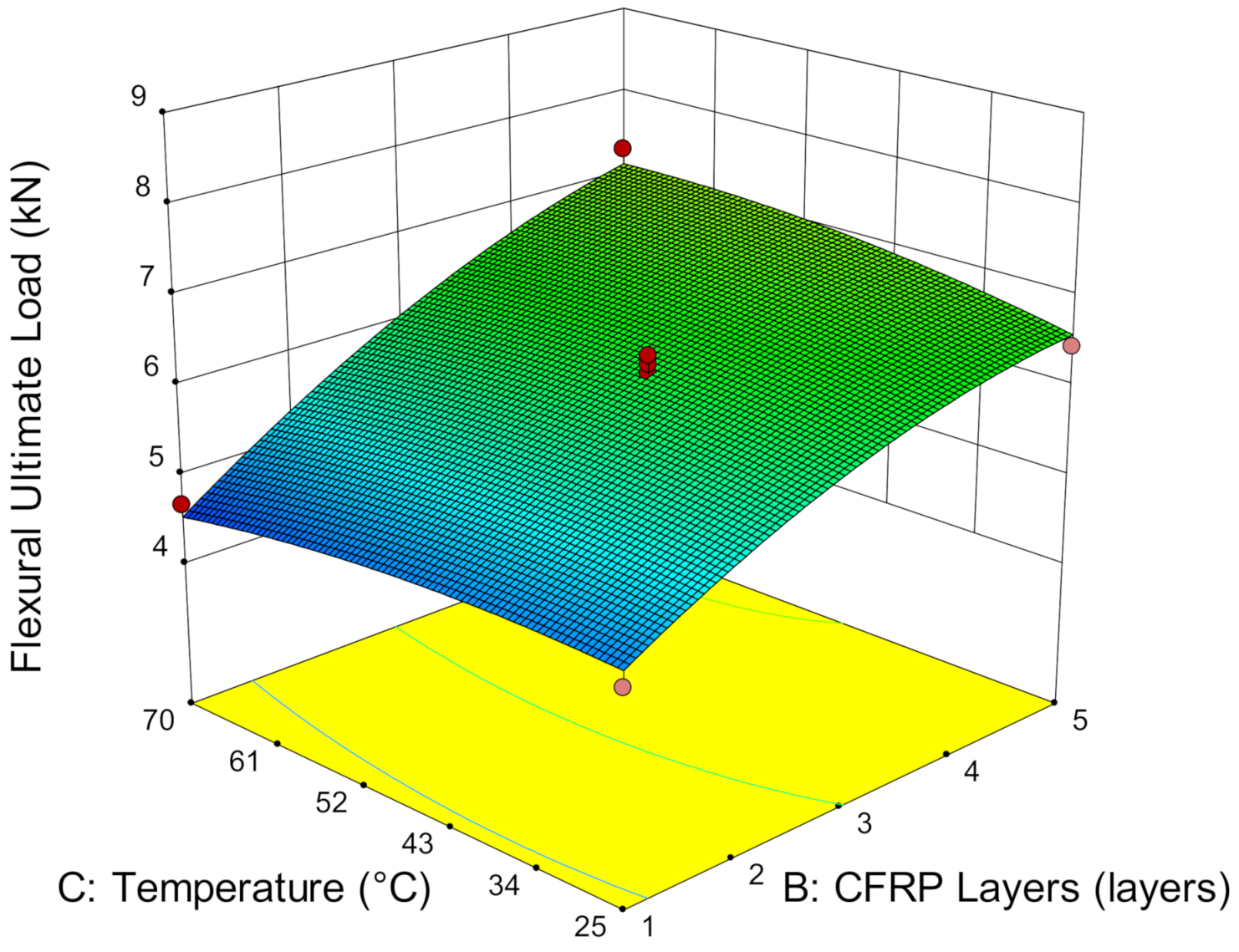
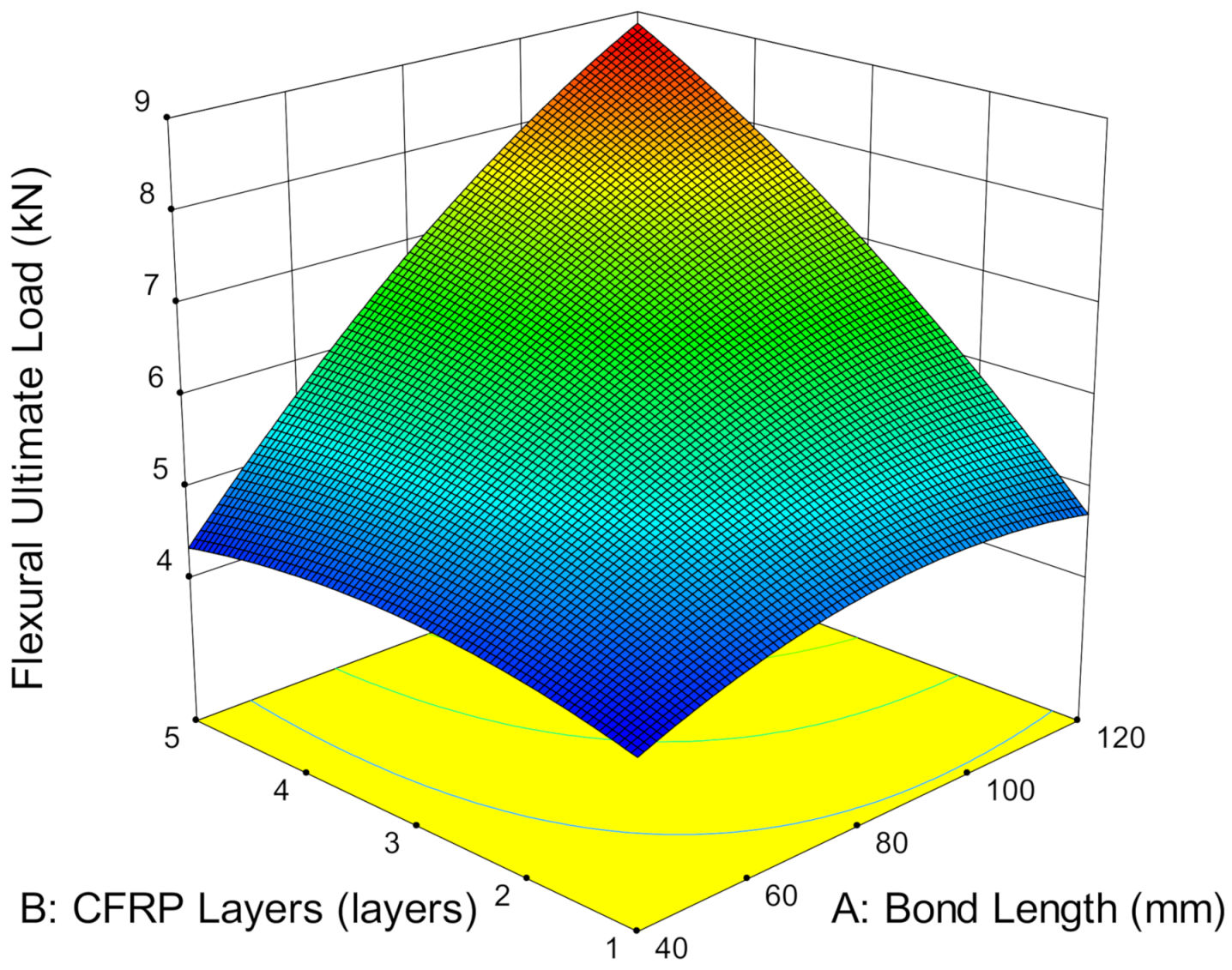

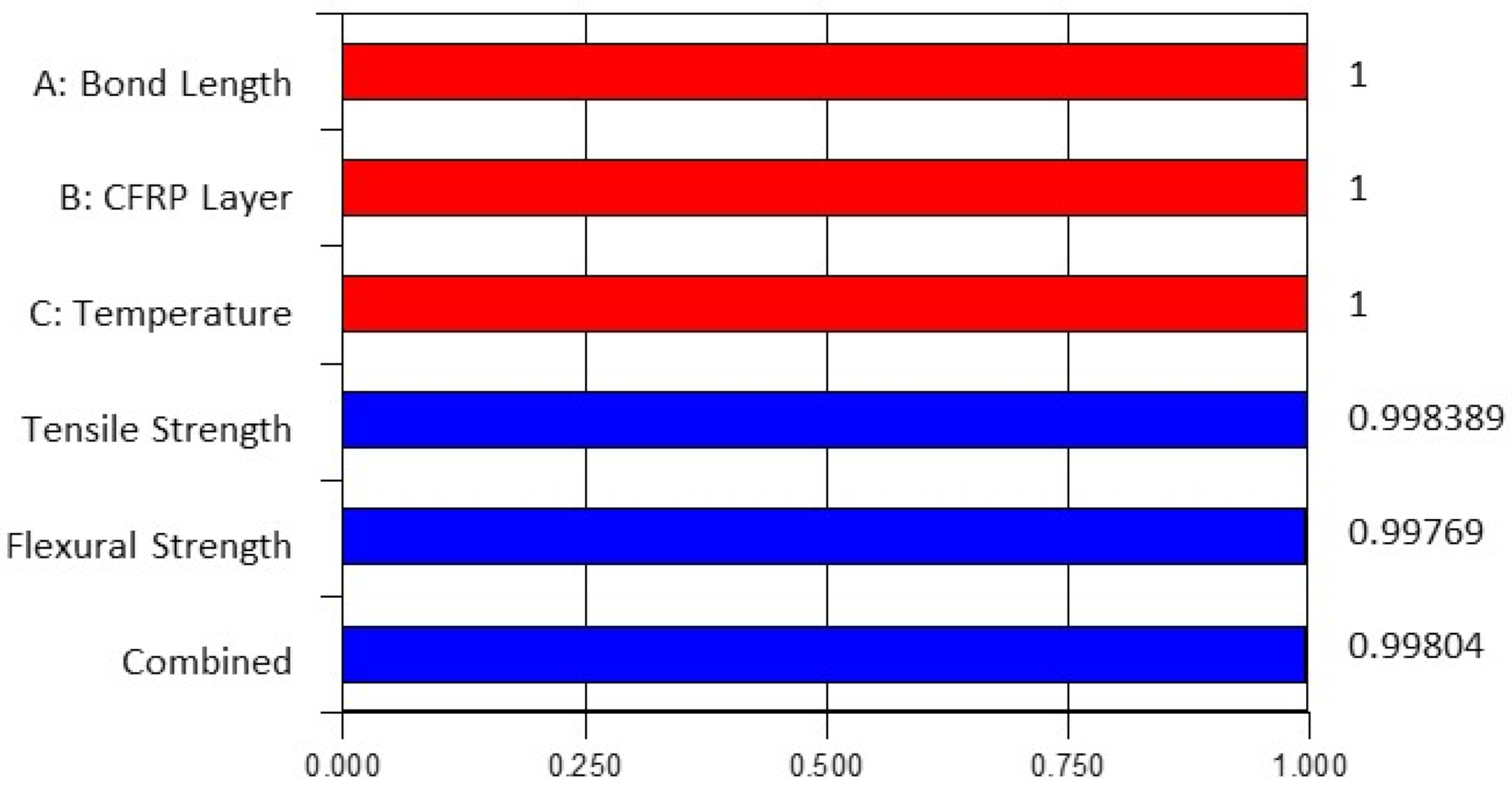

| Material Properties | Steel | CFRP | Epoxy Resin |
|---|---|---|---|
| Yield Strength (MPa) | 345 | - | - |
| Tensile Strength (MPa) | 459 | 4300 | 30 |
| Elastic Modulus (GPa) | 191.43 | 225 | 3.8 |
| Elongation (%) | 30 | 1.91 | 1.5 |
| Bond Length (mm) | Number of CFRP Layers | Temperature (°C) | Tensile Bonding | Flexural Bonding |
|---|---|---|---|---|
| 40 | 3 | 25 | a, e | a, c |
| 80 | 1 | a | f | |
| 80 | 5 | a, c | f | |
| 120 | 3 | a, c | f | |
| 40 | 1 | 45 | b, e | f |
| 40 | 5 | b, d | b | |
| 80 | 3 | b, e, d | b, e | |
| 120 | 1 | b, e, d | f | |
| 120 | 5 | b, d | f | |
| 40 | 3 | 70 | b, d | b |
| 80 | 1 | b, e | f | |
| 80 | 5 | b | b, e | |
| 120 | 3 | b, e, d | d |
| Standard Order | Run | Bond Length (mm) | Number of CFRP Layers | Temperature (°C) | Tensile Strength (MPa) | Flexural Strength (MPa) |
|---|---|---|---|---|---|---|
| 11 | 1 | 80 | 1 | 70 | 105.12 | 9.332 |
| 17 | 2 | 80 | 3 | 45 | 167.28 | 12.494 |
| 4 | 3 | 120 | 5 | 45 | 239.45 | 17.406 |
| 2 | 4 | 120 | 1 | 45 | 91.96 | 9.278 |
| 5 | 5 | 40 | 3 | 25 | 100.10 | 8.457 |
| 12 | 6 | 80 | 5 | 70 | 264.17 | 14.616 |
| 9 | 7 | 80 | 1 | 25 | 83.68 | 9.348 |
| 15 | 8 | 80 | 3 | 45 | 185.80 | 12.511 |
| 1 | 9 | 40 | 1 | 45 | 82.84 | 8.590 |
| 7 | 10 | 40 | 3 | 70 | 196.71 | 8.634 |
| 6 | 11 | 120 | 3 | 25 | 187.59 | 14.662 |
| 10 | 12 | 80 | 5 | 25 | 164.37 | 12.914 |
| 14 | 13 | 80 | 3 | 45 | 172.63 | 13.142 |
| 16 | 14 | 80 | 3 | 45 | 178.12 | 13.144 |
| 13 | 15 | 80 | 3 | 45 | 178.91 | 13.117 |
| 3 | 16 | 40 | 5 | 45 | 171.31 | 8.784 |
| 8 | 17 | 120 | 3 | 70 | 189.58 | 13.657 |
| Response | Source | Sum of Squares | df | Mean Square | F-Value | p-Value Prob > F | Remark |
|---|---|---|---|---|---|---|---|
| Tensile Strength | Model | 44,486.02 | 9 | 4942.89 | 121.44 | <0.0001 | Significant |
| A-Bond Length | 3508.55 | 1 | 3508.55 | 86.20 | <0.0001 | ||
| B-CFRP Layers | 27,096.29 | 1 | 27,096.29 | 665.71 | <0.0001 | ||
| C-Temperature | 5538.99 | 1 | 5538.99 | 136.08 | <0.0001 | ||
| AB | 870.84 | 1 | 870.84 | 21.39 | 0.0024 | ||
| AC | 2216.23 | 1 | 2216.23 | 54.45 | 0.0002 | ||
| BC | 1533.68 | 1 | 1533.68 | 37.68 | 0.0005 | ||
| A2 | 269.14 | 1 | 269.14 | 6.61 | 0.0369 | ||
| B2 | 2066.90 | 1 | 2066.90 | 50.78 | 0.0002 | ||
| C2 | 40.36 | 1 | 40.36 | 0.99 | 0.3525 | ||
| Lack of Fit | 90.00 | 3 | 30.00 | 0.62 | 0.6402 | Not Significant | |
| Flexural Strength | Model | 115.81 | 9 | 12.87 | 49.89 | <0.0001 | Significant |
| A-Bond Length | 53.01 | 1 | 53.01 | 205.53 | <0.0001 | ||
| B-CFRP Layers | 35.82 | 1 | 35.82 | 138.86 | <0.0001 | ||
| C-Temperature | 0.34 | 1 | 0.34 | 1.33 | 0.2873 | ||
| AB | 15.74 | 1 | 15.74 | 61.01 | 0.0001 | ||
| AC | 0.29 | 1 | 0.29 | 1.11 | 0.3262 | ||
| BC | 0.76 | 1 | 0.76 | 2.94 | 0.1301 | ||
| A2 | 4.50 | 1 | 4.50 | 17.44 | 0.0042 | ||
| B2 | 2.93 | 1 | 2.93 | 11.34 | 0.0120 | ||
| C2 | 1.08 | 1 | 1.08 | 4.18 | 0.0803 | ||
| Lack of Fit | 1.33 | 3 | 0.44 | 3.69 | 0.1200 | Not Significant |
| Item | Tensile Strength | Flexural Strength |
|---|---|---|
| Standard Deviation | 6.38 | 0.51 |
| Mean | 162.33 | 11.77 |
| CV. % | 3.93 | 4.32 |
| R2 | 0.9936 | 0.9846 |
| Adj R2 | 0.9855 | 0.9649 |
| Pred R2 | 0.9604 | 0.8102 |
| Adeq Precision | 36.810 | 24.155 |
Publisher’s Note: MDPI stays neutral with regard to jurisdictional claims in published maps and institutional affiliations. |
© 2021 by the authors. Licensee MDPI, Basel, Switzerland. This article is an open access article distributed under the terms and conditions of the Creative Commons Attribution (CC BY) license (https://creativecommons.org/licenses/by/4.0/).
Share and Cite
Lye, H.L.; Mohammed, B.S.; Wahab, M.M.A.; Liew, M.S. Bond Relationship of Carbon Fiber-Reinforced Polymer (CFRP) Strengthened Steel Plates Exposed to Service Temperature. Materials 2021, 14, 3761. https://doi.org/10.3390/ma14133761
Lye HL, Mohammed BS, Wahab MMA, Liew MS. Bond Relationship of Carbon Fiber-Reinforced Polymer (CFRP) Strengthened Steel Plates Exposed to Service Temperature. Materials. 2021; 14(13):3761. https://doi.org/10.3390/ma14133761
Chicago/Turabian StyleLye, Hui Li, Bashar S. Mohammed, Mohamed Mubarak Abdul Wahab, and Mohd Shahir Liew. 2021. "Bond Relationship of Carbon Fiber-Reinforced Polymer (CFRP) Strengthened Steel Plates Exposed to Service Temperature" Materials 14, no. 13: 3761. https://doi.org/10.3390/ma14133761
APA StyleLye, H. L., Mohammed, B. S., Wahab, M. M. A., & Liew, M. S. (2021). Bond Relationship of Carbon Fiber-Reinforced Polymer (CFRP) Strengthened Steel Plates Exposed to Service Temperature. Materials, 14(13), 3761. https://doi.org/10.3390/ma14133761







